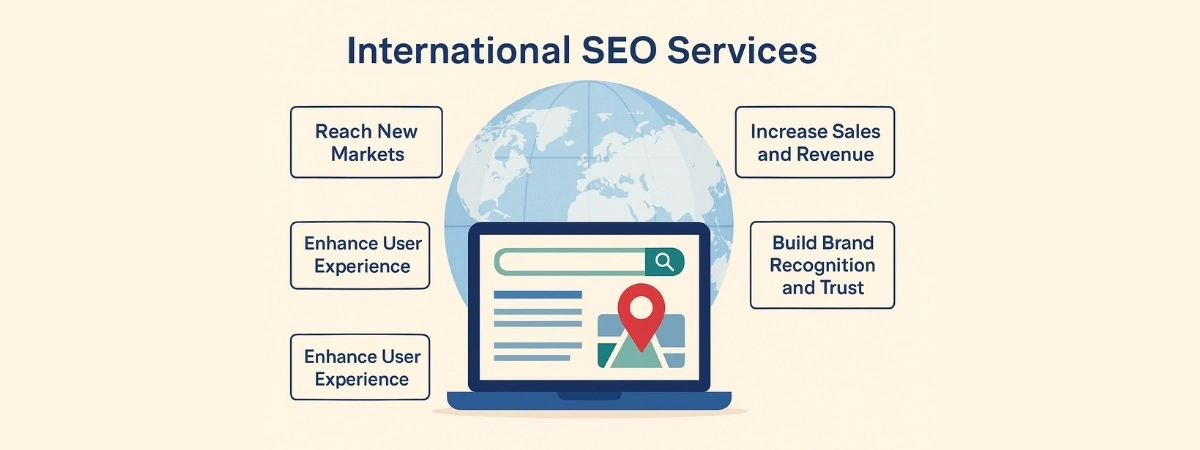Expanding your business beyond borders requires more than just translating your website. It demands a strategic approach to ensure your online presence resonates with diverse audiences worldwide. This is where international SEO services come into play. By optimizing your website for multiple countries and languages, you can enhance visibility, drive targeted traffic, and achieve sustainable growth in global markets.
What Is International SEO?
International SEO involves optimizing your website to rank well in search engine results across different countries and languages. It ensures that search engines can identify the countries you want to target and the languages you use for business. Unlike standard SEO, which focuses on improving visibility in a specific locale, international SEO addresses the complexities of global search environments, including language nuances, cultural differences, and regional search behaviors.
Why International SEO Services Matter
Investing in international SEO services offers several benefits:
1. Reach New Markets
By tailoring your website to different regions, you can tap into new customer bases. For instance, a U.S.-based company expanding into the French market must optimize its content for French-speaking users to compete effectively.
2. Enhance User Experience
Providing content in a user’s native language and considering local customs improves engagement and reduces bounce rates. This localization fosters trust and encourages conversions.
3. Increase Sales and Revenue
Optimizing for international audiences can lead to higher conversion rates. For example, a French skincare brand that translated and optimized its website for German users saw its revenue triple from 5% to 17% in that market.
4. Build Brand Recognition and Trust
Consistent and culturally relevant content across different regions enhances brand credibility. Users are more likely to trust and engage with brands that respect and understand their local context.
Key Components of International SEO
Implementing an effective international SEO strategy involves several critical elements:
1. Choosing the Right URL Structure
Selecting an appropriate URL structure helps search engines and users understand your site’s targeting. Common structures include:
-
ccTLDs (Country Code Top-Level Domains): e.g.,
example.frfor France. -
Subdomains: e.g.,
fr.example.com. -
Subdirectories: e.g.,
example.com/fr/.
Each structure has its pros and cons regarding maintenance, geotargeting, and SEO equity.
2. Implementing Hreflang Tags
Hreflang tags inform search engines about the language and regional targeting of your pages, preventing duplicate content issues and ensuring users see the correct version of your site. Proper implementation involves adding the hreflang attribute to your site’s HTML or XML sitemap, specifying the language and region codes.
3. Conducting Region-Specific Keyword Research
Search behaviors vary across regions. A term popular in one country might be irrelevant in another. Utilize tools like Ahrefs or Google Keyword Planner to identify and target keywords specific to each market.
4. Localizing Content Beyond Translation
Localization involves adapting content to fit the cultural and linguistic nuances of a region. This includes adjusting idioms, images, and even color schemes to resonate with local audiences. For instance, a marketing campaign successful in the U.S. might need significant changes to appeal to Japanese consumers.
5. Optimizing Technical SEO Elements
Ensure that your website’s technical aspects, such as page load speed, mobile responsiveness, and secure connections (HTTPS), meet the expectations of users in different regions. Utilizing a Content Delivery Network (CDN) can help deliver content faster to international users.
Best Practices for International SEO
To maximize the effectiveness of your international SEO efforts, consider the following best practices:
1. Define Your Target Markets
Identify which countries and languages offer the most potential for your business. Analyze market demand, competition, and your company’s capacity to serve these markets effectively.
2. Use One Language Per Page
Avoid mixing multiple languages on a single page. This clarity helps search engines index your content accurately and provides a better user experience.
3. Ensure Consistent Internal Linking
Maintain internal links within the same language and regional context. This not only improves site structure but also enhances usability for international users. If you’re managing a multilingual site from India, you might want to explore our professional SEO Services in India for localized strategy and implementation.
4. Avoid Automatic Redirection Based on IP
Redirecting users solely based on IP addresses can lead to incorrect language or regional versions being displayed. Instead, allow users to choose their preferred language or region.
5. Build Local Backlinks
Acquire backlinks from reputable local websites to enhance your site’s authority and relevance in specific regions. This strategy signals to search engines that your content is valuable to local audiences.
Common Challenges in International SEO
While international SEO offers significant benefits, it also presents challenges:
-
Duplicate Content: Without proper hreflang implementation, similar content across different regions can be seen as duplicate content by search engines.
-
Cultural Missteps: Failing to understand local customs and preferences can lead to content that alienates rather than engages.
-
Technical Complexities: Managing multiple versions of a website increases the complexity of site maintenance and SEO efforts.
Conclusion
Expanding your digital presence globally through international SEO services is a strategic move that can lead to increased traffic, higher conversions, and greater brand recognition. By understanding and implementing the key components and best practices outlined above, your business can effectively navigate the complexities of global markets and achieve sustainable growth.


